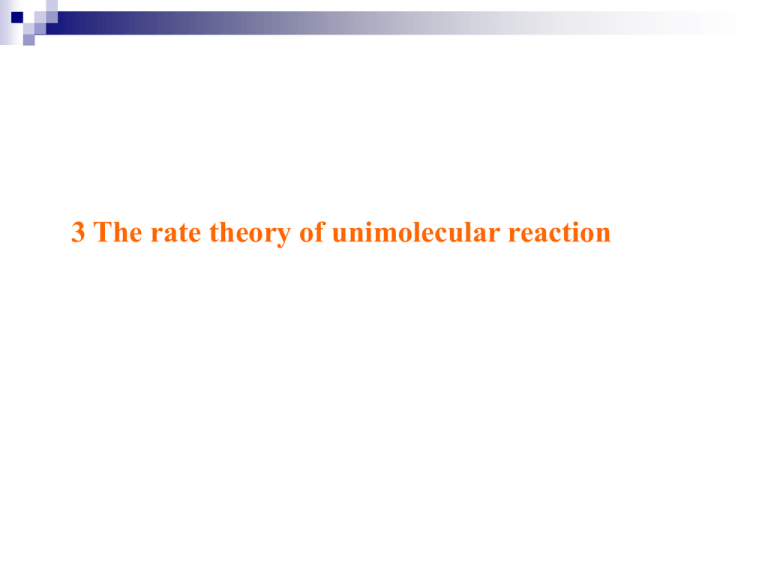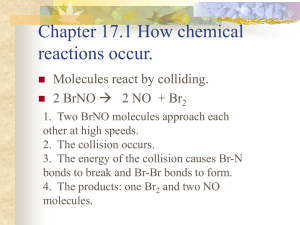幻灯片 1
advertisement

3 The rate theory of unimolecular reaction Unimolecular reaction is elementary reaction with only one reactant molecule. It is obvious that a single molecule at ground state will not undergo any reaction except that it was activated by energy of some types. A A* P For unimolecular reaction, the puzzling question is that how do reactant molecules acquire necessary activation energy. At early 19th century, it was found that all unimolecluar reaction, such as gaseous decomposition and isomerization, is of first-order. For bimolecular reaction, before reaction takes place, reactants must collide with each other to acquire enough activation energy. This may lead to a conclusion that all gaseous reaction should be second-ordered. In 1919, Perrin proposed that, for unimolecular reaction, the reactant molecule was activated by absorption of infrared radiation from the container or other molecules – radiation activation theory. k1 radiation A A* P dP k1[A* ] dt The result obtained from the radiation activation theory is in good accordance with the early observation of kinetic characteristics of the unimolecular reaction, i.e., unimolecular reaction is of first-order. Problems proposed by Langmuir : 1) the energy of the infrared radiation of the wall of container is very low and is not sufficient for activation. 2) some reactant molecules do not have an absorption band in the wave-length region of infrared radiation. 3) Latterly, it was observed that the unimolecular reaction is of second-order at low pressure and first-order at high pressure. k∞ A In 1921, Christiansen postulated that the activation of molecules in unimolecular reaction is also through intermolecular collision. For this theory, it is easy to explain the second-ordered feature of unimolecular reaction at low pressure but it is impossible to gave any reasonable explanation to its firstordered feature at high pressure. In 1922 Lindemann and Christiansen postulated that the activated molecules react long after the collision. There is a time lag between activation and reaction. During the stay of activated molecules, some of them may lose their energy due to the further collision (deactivation). Only part of the activated molecules form product. 3.1 Lindemann mechanism 1) Activation through collision: A M A* M k1 2) deactivation through collision during time lag k1 A* M A M 3) decomposition of activated molecule after time lag A P * k2 It is obvious that the activation and the deactivation processes are bimolecular reactions and the decomposition process is truly a unimolecular reaction. 3.2 Rate equation of Lindemann mechanism The rate of the reaction can be given as: d [A* ] r k2 [A* ] dt To determine the concentration of activated molecules, the stationary-state approximation should be used. the stationary-state approximation If A* is very active, its concentration is very low and after a short time, its concentration does not vary with time: d [A* ] 0 dt Lindemann mechanism d [A* ] k1[A][M] k1[A* ][M] k2 [A* ] dt k1[A][M] d [A* ] * 0 [A ] k1[M] k2 dt * d [A ] r k2 [A* ] dt k1k2 [A][M] r k1[M] k2 This equation suggests that unimolecular reaction have no definite reaction order. discussion k1k2 [A][M] r k1[M] k2 Case I: When the pressure of the system is low enough to satisfy: k1[M] k2 r k1[A][M] When the pressure and the concentration of A and M is low, the collision frequency is low and thus the deactivation is rare. discussion k1k2 [A][M] r k1[M] k2 Case II: At high pressure, the collision frequency is high and thus the deactivation is fast. When the rate of deactivation is much higher than the rate of decomposition k1[M] k2 k1k2 [A][M] r k '[A] k1[M] This is an expression for the pseudo-first-order reaction. k1k2 r [A] k [A] k1 r k [A] r k1k2 [A][M] k1[M] k2 r k1[A][M] The Lindemann mechanism can satisfactorily explain the phenomena of the unimolecular reaction. experimental Lindemann The quantitative calculation of Lindermann mechanism was poor. To modify Lindemann mechanism, Hinshelwood used theory of energy partition to calculate k1, but the result is still not satisfactory. 3.3 RRKM theory In 1930s, Rice-Ramsperger-Kassel established another mechanism for unimolecular reaction. In 1950, Marcus innovated the mechanism and introduced TST into the treatment of unimolecular reaction. Rudolph A. Marcus 1992 Noble Prize USA Theories of electron transfer In which A is energized molecules They postulated that, before A* decomposed to product, the energy they attained must be transferred to the chemical bond to break and the molecules must attain the transition state (A, energized molecule) with special configuration similar to product. The time needed for configuration transformation corresponds to the time lag proposed by Lindemann. experimental RRKM






